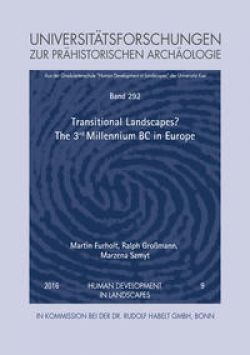Transitional Landscapes? The 3rd Millennium BC in Europe
Proceedings of the International Workshop "Socio-Environmental Dynamics over the Last 12,000 Years: The Creation of Landscapes III (15th -18th April 2013)" in Kiel
Produktform: Buch / Einband - fest (Hardcover)
A set of narratives dominates the discussions on the 3rd millennium BC in Central and Northern Europe. They are linked to several especially marked or emblematic features of the archaeological record, namely the extraordinary spatial extent of archaeological units of classification, extraordinary homogeneity of material culture within these units, widespread changes in the burial customs, marked changes in settlement patterns, and a perceived continuity into the Early Bronze Age. The formation of the Corded Ware and Bell Beaker units are – as the narrative goes – the results of or indicate a fundamental reorganisation of society (more hierarchic and patriarchic, as well as widened networks), which is either caused by internal developments, or by a wave of massive migration from the east, or west respectively, in the course of which the aforementioned new forms of social relations, a new economic basis (pastoralism, metallurgy) and new ideological systems (highlighted individual and gender-roles) are established. This, so the narrative continues, is a prelude to the European Bronze Age.
The workshop-session published in this volume, “Transitional Landscapes? Spatial Patterns, Standardised Burials and Intensified Communication in the 3rd Millennium BC in Europe” was held in the spring of 2013 in Kiel. Its main idea was to bring together those colleagues working in different regions and on different aspects of the 3rd millennium BC in Europe in order to evaluate the prevailing overall narratives connected to the time period from different local and regional perspectives. The motivation to do so stemmed from the view that these narratives brush over an amount of local, regional and temporal variation that would, if acknowledged, seriously question their accordance with the archaeological record. Additionally, in order to understand the social phenomena connected to the fascinating new data provided by molecular biologists – favouring massive migration from the east – the discussion of the archaeological evidence from local and regional contexts, as presented in this volume, is as crucial as it has ever been.weiterlesen
Dieser Artikel gehört zu den folgenden Serien
65,00 € inkl. MwSt.
kostenloser Versand
lieferbar - Lieferzeit 10-15 Werktage
zurück

